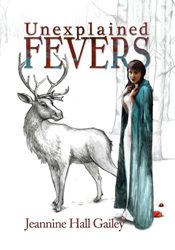
Some say, okay, they say, it is they who say, History is written by the victors. By way of counterpoint, I say, History is written by the writers. As are fiction, poetry, legend, myth, fairy tale, not to mention inventory lists which were hammered out in cuneiform in old Mesopotamia. But that’s a different story.
This is a story of Unexplained Fevers, Jeannine Hall Gailey’s third collection, in which Gailey, the poet laureate of Redmond, Washington (a small town housing offices of Bill Gates’ modest enterprise) pushes back on the received wisdom of glass slippers and damsels distressed like jean jackets in a consignment shop.
Given the illustrations on front and back cover — a conventionally lovely young woman — slim, anglo, and long-haired — wearing a long cape in the forest, a wolf gripping a bloodied basket in his teeth — “Once Upon a Time,” the first poem, serves as confirmation and signal of the poet’s intent. It is also reminder of romantic love’s pitfalls and very much a warning. If Alex Trebek asked me, “Things you’d like to tell your grandniece,” I’d answer, “‘Once Upon a Time’ by Gailey.” Random lines: “We should have mapped.” “We should have touched the dirt.” “We should have guessed.” Finale: “We couldn’t keep our stories straight. / It wasn’t as they had told us.”
That clincher is Gailey’s volley into a collection of re-envisionings of western civilization’s stock stories. They misled us. News to no one who has loved crazy, believed Disney, Seventeen, or the constellations of legends about, say, Andromeda, chained to a rock, until bad boy Perseus jets on by. But useful to remember.
With bold statement and swiftly conveyed image, Gailey sings counterpoint. “It wasn’t you, sweet prince, or our tiny castle / (the dust mounting in closets) or the crying / wounded mouths of children. / It was sunlight that burned my memory. / It was my lips that craved a sweeter fruit.” This righteously titled, “She Justifies Running Away” ends with a kicker of a couplet crying out for freedom and bounding out of repression’s slippery grasp. “It was the white, frolicking goats in me that called. / I will shuck myself open to the blue hot world.” I hear Carly Simon singing, and, please, I do not mock. For one, I loved the “I Am Woman” chanteuse belting out “Let the River Run” on the Staten Island Ferry. Furthermore, and back to the poem, the rhythmic force of “shuck myself” – the shock of the stress – the image of disrobing and revealing meat and essence of self – carry the meaning like it’s a crown on a velvet pillow about to be tossed into the air. I can’t say exactly what a “blue hot” world is, but the image itself of glass, quickly melting ice, expansive (and blue) (and hot) sky precludes specificity of knowing. Precluding specificity of knowing is my way of saying: herein lies poetry.
There is talk (by them) that the Brothers Grimm “rescued” folklore of the people by collecting first-person accounts of the European tradition. According to Santa Cruz professor John M. Ellis in One Fairy Story Too Many: The Brothers Grimm and Their Tales, a book I read twenty years ago, the duo had far less contact with the volk when collecting, than they claimed; then doctored and moralized the “peasant” tales, some beyond recognition. It’s not that the oral tradition was feminist or pro-choice, but it did more closely mirror life as is, than did the Grimm’s stories. Grimm’s Tales was the only banned book in my childhood. It reportedly gave my sister nightmares. The only banned movie was Butterfield 8 with Elizabeth Taylor. Backchannel me, if you wish.
 History, story, myth exist to be fodder. Recently, for instance, Rachel Zucker reimagined Persephone in her collection, Eating in the Underworld. It might be argued that Gailey is neither better nor worse intentioned than the Grimm boys, as she – because she – rewrites, but I recognize her stories from life, not from nightmare. With an exception, not small, which I note in the final paragraph of this review, the observable mass, female and male, serves as her stories. This review may shine a greater light on subject matter than on the poems, but only because the content in Unexplained Fevers is, well, there. And rich. We like content.
History, story, myth exist to be fodder. Recently, for instance, Rachel Zucker reimagined Persephone in her collection, Eating in the Underworld. It might be argued that Gailey is neither better nor worse intentioned than the Grimm boys, as she – because she – rewrites, but I recognize her stories from life, not from nightmare. With an exception, not small, which I note in the final paragraph of this review, the observable mass, female and male, serves as her stories. This review may shine a greater light on subject matter than on the poems, but only because the content in Unexplained Fevers is, well, there. And rich. We like content.
Anyway, as we (you and me) know that everyone, male and female in all permutations, becomes disappointed or led astray by the promises, images, and re-spun narratives of the culture. Pity, therefore, not just the princess, but also the prince. In “The Knight Wonders, What, Exactly, He Rescued” one of the noble archetypes, the rescuer of good heart in armor shining, draws the same conclusion as have the women in these poems.
He makes dinner for the two of them,
gently snapping asparagus in two, cutting
the fascia away from a chicken breast with a sigh.
A backfire, a black spire, a fear ark, a fae bicker:
a creature with a beautiful song and sharp claws.
Nothing the way he pictured it.
I was a little uncertain if the prince’s state of flummox was overly related to his having a real woman, as we say, on hand. That’s not a quibble in a collection about disappointment and the need to readjust our sites. But as he isn’t mocked by the poet, he becomes another misled human. One of us.
Truth is, I resisted reviewing this collection, and worked to break down my prejudice against what initially felt like pretty girl, heterosexual, white person lament. But I learned that I can and do exist in the poems. Even as we wittily comment on Facebook or buy drinks at poetry readings, the Bill of Rights is being repurposed by our officials. The real-time desecration necessitates slight, subtle, massive, and heart-crushing retellings and interpretations of history. It is especially important that the writers, the poets, document what we see and hear, and what we feel. This poetic eye-level history will require a diversity, as in honest and accurate representation and span of writers from all economic levels. Following Gailey’s lead, which builds on many other poets and tale-tellers, I can and must write my poems, and read yours.
The End




